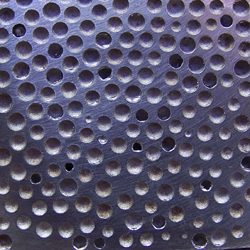"Metallic foam", which has a degree of flexibility similar to that of bone, could be a new generation for biomedical implants that will prevent rejection of implants and lead to financial savings. The new material was developed by researchers from the University of North Carolina

In their new article, the researchers reported updated findings that showed that in addition to the material's very high ability to absorb energy and its low weight, its modulus of elasticity is very similar to that found in bone. The modulus of elasticity examines the degree of deformation of the material in response to the pressure applied to it and its ability to return to its original state when the pressure is removed. The rough surface of the foam will also help in the growth of bone inside the implant so that the stiffness of the final implant will be increased.
The modulus of elasticity, measured in gigapascals (pressure units) is a very important characteristic of biomedical implants, explains Dr. Afsaneh Rabiei, professor of mechanical and aerospace engineering at the University of North Carolina.
"When an orthopedic or dental implant is inserted into the body to replace a bone or a part of the bone, it must bear the appropriate weight in the same way that the bones around it do," explains the researcher. "If the modulus of elasticity of the implant is too high than the bone, most of the weight will be transferred to it and the neighboring bones will want to fade and "die". This will eventually lead to the detachment of the implant and the failure of healing. This phenomenon is known as stress shielding. When this happens, the patient will need corrective surgery to replace the implant. Our composite foam could be a perfect solution to prevent this phenomenon," notes the lead researcher.
In order to explain the difference in the modulus of elasticity of normal bones and implants, we note that natural bone has a modulus that ranges from ten to thirty gigapascals, while titanium implants have a value of one hundred gigapascals. The new composite foam has a modulus close to that of bone, and is relatively light-weight thanks to its porous structure.
The rough surface of the metal foam, notes the lead researcher, "will bind well to the new bones that will grow around the implant, which will allow the body to grow bones inside the pores of the implant. This fact will increase the mechanical durability and rigidity of the implant inside the body."

One response
"Modulus of elasticity" is an accepted term in engineering. Whereas "modulus" is just an unsuccessful translation.